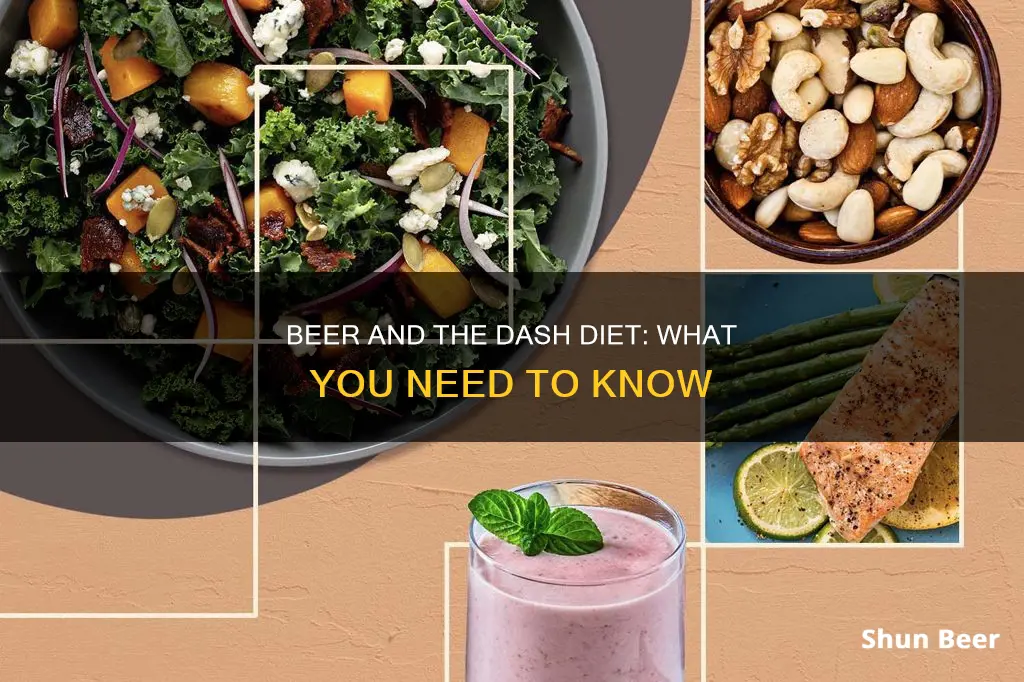
The DASH diet, or Dietary Approaches to Stop Hypertension, is a diet designed to lower blood pressure and reduce the risk of heart disease. It involves eating more fruits, vegetables, whole grains, and lean meats, and less red meat, salt, added sugars, and fat. The diet does allow for alcohol, but only in moderation – one drink per day for women, and two for men.
| Characteristics | Values |
|---|---|
| Alcohol allowed? | Yes, but in moderation (1 drink per day for women, 2 drinks per day for men) |
| Beer allowed? | Yes, but in moderation |
What You'll Learn

Beer and the DASH diet: what's allowed?
The DASH diet, which stands for Dietary Approaches to Stop Hypertension, is a popular eating plan designed to help lower blood pressure and reduce the risk of heart disease. While the diet does not specifically prohibit any food or drink, including alcohol, it does recommend limiting certain items like salt, sugar, and fat. So, what does this mean for beer drinkers?
The good news for beer lovers is that the DASH diet does allow for alcohol consumption. However, moderation is key. According to the DASH guidelines, women should limit their intake to one drink per day, while men should stick to no more than two drinks per day. Binge drinking is strongly discouraged as it can lead to elevated blood pressure and damage to vital organs like the liver, brain, and heart.
Best Types of Beer on the DASH Diet
When it comes to choosing the best type of beer to drink on the DASH diet, light beers are generally a better option from a dietary standpoint. Light beers tend to be lower in calories and carbohydrates compared to regular beers. However, it's important to read the labels and compare the nutritional information of different brands to make an informed choice. Additionally, pairing your beer with a healthy meal that aligns with the DASH diet guidelines can help you stay on track.
Other Alcoholic Beverages on the DASH Diet
While the DASH diet does not specifically prohibit any type of alcohol, it's worth noting that red wine is often recommended as a heart-healthy option. Red wine contains antioxidants and resveratrol, which may offer additional health benefits like anti-aging properties and a reduced risk of certain cancers. However, other alcoholic beverages like spirits and cocktails should be consumed in moderation and may require adjustments to fit within the DASH diet guidelines.
Non-Alcoholic Beverage Options on the DASH Diet
If you're looking for non-alcoholic beverage options that align with the DASH diet, there are plenty of choices. Water is always a healthy and refreshing option, and the diet also encourages the consumption of fruit juices, although preferably fresh and not store-bought to limit added sugars. Coffee and tea are also allowed on the DASH diet, but be mindful of added sugars and creamers that can increase the calorie count.
The DASH diet is a flexible and balanced eating plan that can accommodate the occasional beer or alcoholic beverage. However, it's important to prioritize moderation and be mindful of the overall nutritional content of your choices. Remember to always consult with a healthcare professional before starting any new diet or making significant changes to your alcohol consumption.
Drinking Beer in Public: Italian Laws and Culture
You may want to see also

How does the DASH diet work?
The DASH diet, which stands for Dietary Approaches to Stop Hypertension, is a healthy-eating plan designed to lower high blood pressure. It is also recommended for people who want to reduce their chance of developing heart disease. The diet focuses on fruits, vegetables, whole grains, and lean meats, and it is low in red meat, salt, added sugars, and fat.
The DASH diet recommends a specific number of servings from different food groups, depending on how many calories you need to consume daily. For a 2,000-calorie diet, the DASH diet suggests the following:
- Four to five servings of fruit per day (1/2 cup per serving of fresh, canned, or frozen fruit)
- Four to five servings of vegetables per day (1/2 cup per serving)
- Six to eight servings of whole grains per day (1/2 cup of grains or 1 slice of bread per serving)
- Two or three servings of low-fat or fat-free dairy per day (1 cup of milk or yogurt per serving)
- Six or fewer servings per day of meat, chicken, or fish (1 ounce per serving)
- Two or three servings per day of heart-healthy fats and oils (1 teaspoon per serving)
- Four or five servings of nuts, seeds, dry beans, peas, and five or fewer servings of sweets per week
The DASH diet restricts sodium intake to no more than 3/4 teaspoon (1,500 milligrams) of sodium per day. This is equivalent to about 1 teaspoon of table salt.
In addition to lowering blood pressure, the DASH diet has been linked to a number of other potential health benefits, including a lower risk of cancer, metabolic syndrome, and diabetes, as well as improved insulin resistance.
The DASH diet does allow for alcohol consumption, but in moderation. Dieters should stick to one drink per day for women and no more than two drinks per day for men. Binge drinking can elevate blood pressure and damage the liver, brain, and heart, so moderation is key.
Beer and the DASH Diet: What You Need to Know
You may want to see also

What are the health benefits of the DASH diet?
The DASH diet, or Dietary Approaches to Stop Hypertension, is a healthy-eating plan designed to reduce high blood pressure. It is scientifically proven to lower blood pressure and cholesterol, reduce the risk of diabetes, and lower the risk of heart disease and strokes. The DASH diet is also associated with a number of other health benefits.
Firstly, the DASH diet can lead to weight loss. While not initially designed as a weight-loss programme, the diet has been shown to result in an average loss of around 5 lbs in the first two weeks, with a further loss of between 10 lbs and 35 lbs over the next two months.
Secondly, the DASH diet may reduce the risk of certain types of cancer. A 2019 review found that people following the DASH diet had a lower risk of breast, hepatic, endometrial, and lung cancer. A separate study found a similar result for colorectal cancer.
Thirdly, the DASH diet may reduce the risk of metabolic syndrome. Research suggests that the diet reduces the risk of metabolic syndrome by nearly 50%.
Fourthly, the DASH diet may improve insulin resistance and reduce the risk of diabetes.
Finally, the DASH diet may be linked to a lower chance of developing heart disease. Research suggests that the diet may help lower various risk factors for heart disease, such as blood cholesterol, sugar, and fats.
The DASH diet is recommended for people who want to prevent or treat high blood pressure and reduce their chance of developing heart disease. It focuses on fruits, vegetables, whole grains, and lean meats, and is low in red meat, salt, added sugars, and fat.
Is Beer Safe During Pregnancy?
You may want to see also

What foods can you eat on the DASH diet?
The DASH diet, or "Dietary Approaches to Stop Hypertension", is a nutritional intervention for lowering blood pressure. The diet is flexible and balanced, focusing on eating a specific number of servings from different food groups. It does not emphasise special foods to eat but instead recommends a high intake of certain food groups and a limited intake of others.
The DASH diet generally emphasises a high intake of fruits, vegetables, low-fat or non-fat dairy, nuts, seeds, lentils, beans, and whole grains. It limits the consumption of red and processed meat, sweets, soda, and sodium (salt).
- Four to five servings of fruit per day (1/2 cup per serving of fresh, canned, or frozen fruit)
- Four to five servings of vegetables per day (1/2 cup per serving)
- Six to eight servings of whole grains per day (1/2 cup of grains or 1 slice of bread per serving)
- Two or three servings of low-fat or fat-free dairy per day (1 cup of milk or yoghurt per serving)
- Six or fewer servings per day of meat, chicken, or fish (1 ounce per serving)
- Two or three servings per day of heart-healthy fats and oils (1 teaspoon per serving)
The diet also encourages four to five servings of nuts, seeds, dry beans, and peas per week, as well as limiting sweets to five servings or fewer per week.
Regarding salt intake, the DASH diet allows for 2,300 milligrams (mg) daily, which is equivalent to about 1 teaspoon of table salt. Some people may opt for an even lower sodium goal of 1,500 mg, which can help lower blood pressure even further.
Mastering Beer: CFT Mastercan's Magic
You may want to see also

Is the DASH diet suitable for everyone?
The DASH (Dietary Approaches to Stop Hypertension) diet is a flexible, well-balanced eating plan that focuses on reducing blood pressure and the risk of heart disease. It is not a weight-loss diet, but it can help with weight loss. It is also not a low-carb diet.
The DASH diet is suitable for people who want to prevent or treat high blood pressure and reduce their risk of heart disease. It is also suitable for people with diabetes, gout, and depression or anxiety. The diet is backed by scientific studies and has been endorsed by the American Heart Association.
The DASH diet is generally rich in fruits, vegetables, whole grains, low-fat or non-fat dairy, beans, nuts, seeds, and lean proteins like fish or chicken. It limits the intake of red and processed meat, soda, sweets, and salt. The diet recommends a maximum of one or two alcoholic drinks per day for women and men, respectively.
However, the DASH diet may not be suitable for everyone. While it can be adapted to suit different dietary restrictions, such as vegetarian or vegan preferences, it may need to be modified for certain health conditions. For example, people with celiac disease should choose gluten-free foods, and those with lactose intolerance should opt for lactose-free products or take a lactase pill when consuming lactose-containing foods.
Additionally, the benefits of the DASH diet may vary depending on individual factors. Studies suggest that the greatest reductions in blood pressure occur in those with the lowest salt intake, particularly people with high blood pressure, older adults, or non-white adults. In contrast, the effects of reducing salt intake seem to be smaller in people with lower blood pressure, white adults, or younger adults.
Furthermore, while the DASH diet can help with weight loss, this may not be a significant benefit for individuals who are already at a healthy weight. In such cases, following general balanced eating guidelines may be sufficient to maintain a healthy weight and lower the risk of heart disease.
Therefore, while the DASH diet can be adapted to suit various dietary preferences and restrictions, its effectiveness may vary depending on individual health needs and goals. It is always recommended to consult a healthcare provider or a registered dietitian before starting any new diet to ensure it is appropriate for your specific needs.
Beer and Weight Loss Surgery: What You Need to Know
You may want to see also
Frequently asked questions
The DASH diet is not a low-carb diet. It is a health diet, not a figure diet. It is meant to improve your cardiovascular health and help you live longer, not to help you get ready for summer at the beach.
DASH stands for "Dietary Approaches to Stop Hypertension". It is a combination diet that aims to control blood pressure. It is meant to eat the right foods to help maintain normal blood pressure and to steer clear of the ones that aggravate hypertension such as sodium.
The DASH diet does not restrict alcohol consumption. However, it is recommended that you stick to one or two drinks a day for women and men, respectively. Binge drinking can elevate blood pressure and damage the liver, brain, and heart, so moderation is key.
The DASH diet is rich in fruits, vegetables, whole grains, low-fat dairy, beans, nuts, seeds, lean proteins like fish or chicken. It limits the intake of red and processed meat, soda, sweets, and salt.
The DASH diet does not allow for a lot of red meat, salt, added sugars, and fat.







